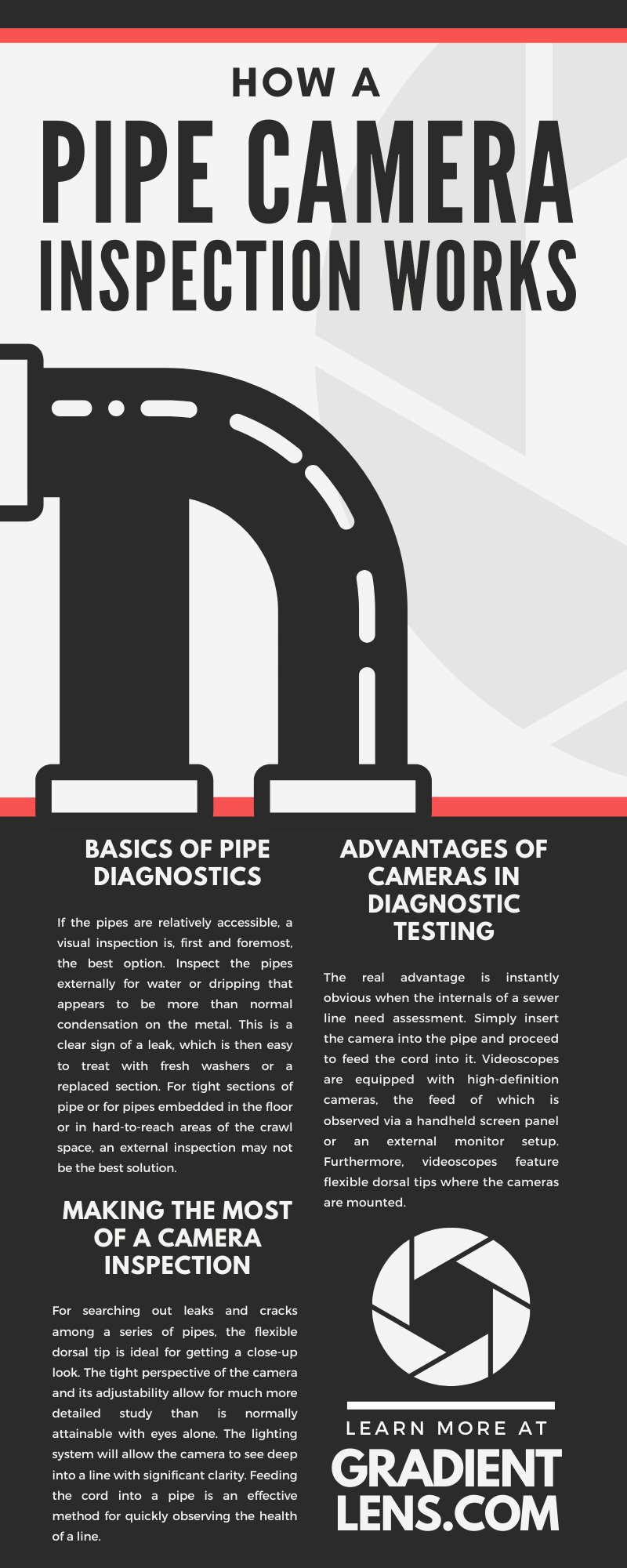How a Pipe Camera Inspection Works

June 1, 2021
Homeownership comes with many responsibilities, some of which aren’t immediately obvious. A vast array of care and upkeep tasks arise from within the walls and even deep in the ground surrounding a home. We may like to imagine home care as consisting simply of decorating and occasionally painting a room a new color, but there’s more to it than that. Unlike renters, homeowners must attend to the essential utilities. The amount of work that really goes into protecting a home and its essential functions from the wear and tear of weather and time may easily catch first-time homeowners off guard.
The one key utility most likely to need attention is the plumbing system, especially in older homes, as age, cold seasons, and normal house-shifting often cause surprise incidents. The older the pipes are in a home, the more likely it is for something to go amiss. A yearly revisiting of your home’s pipes and sewer lines plus regular cleaning will ensure you can circumnavigate most problems. Knowing how a pipe camera inspection works makes finding and checking on larger issues a simpler task. Through preventative efforts, homeowners can plan for more expensive costs down the line and avoid getting caught off if and when a break or blockage does happen.
Common Sewer Line Issues
The mere mention of plumbing problems is usually enough to send most people running. Any property manager or experienced homeowner is likely more experienced in such matters than they would like to be. Any system that routinely interacts with water is bound to wear down relatively quickly compared to other utilities such as electrical or data wiring. Sewer lines have the additional complication of interacting with a home’s septic system. Depending on the age of the house, this too can have significant complications and vastly different inner workings.
Regardless of the type of plumbing with which your home is equipped, a few common signs signal that potentially larger problem is rapidly approaching. To begin with, a moldy smell is a good indicator of a leak somewhere in the house. Smelling or identifying mold on the walls or ceilings is a signal that the break is in a water line within the walls.
A sewer odor speaks of a similar break, though it will likely originate from a crack in a sewer line beneath the house. Severe leaks, if left unattended beneath the home, are known to cause excessive shifting over a relatively short period, which the home often experiences in the form of cracking drywall, gradients in the floor, and doors becoming stuck or too loose.
Finally, a much less dramatic scenario is a simple block. A clog can occur just about anywhere in a pipe. Almost everyone has had to call in a plumber for blocks in the kitchen and bathrooms. The most common and less-than-fun way to notice a blockage is the inevitable flooding of showers, tubs, sinks, and toilets. Which fixture signals a failure to drain is a good clue as to which pipe is suffering from debris buildup.
Basics of Pipe Diagnostics
Diagnosing internal issues in a home is never easy. Often, problems such as leaks in the wall demand a thorough exploration, which will include dismantling a section of the wall. It may seem like a lot of trouble, but insulating and hanging a fresh piece of drywall is much less effort than dealing with the resulting smells and headaches of mold growth. The same is true of sewer lines, depending on how accessible the pipes below the house are. Homes with basements likely have a utility section, making the work a little easier. Otherwise, access via the crawl space or by cutting a section of the floor is the next best option.
If the pipes are relatively accessible, a visual inspection is, first and foremost, the best option. Inspect the pipes externally for water or dripping that appears to be more than normal condensation on the metal. This is a clear sign of a leak, which is then easy to treat with fresh washers or a replaced section. For tight sections of pipe or for pipes embedded in the floor or in hard-to-reach areas of the crawl space, an external inspection may not be the best solution.
Advantages of Cameras in Diagnostic Testing
Understanding how a pipe camera inspection works saves plumbers and DIYers precious time, money, and effort. For starters, the most commonly used type of camera is a borescope, and generally a videoscope at that. There are many different models and varieties, but any device equipped with a borescope light system will be most effective in the often dark and cramped spaces around pipes.
The real advantage is instantly obvious when the internals of a sewer line need assessment. Simply insert the camera into the pipe and proceed to feed the cord into it. Videoscopes are equipped with high-definition cameras, the feed of which is observed via a handheld screen panel or an external monitor setup. Furthermore, videoscopes feature flexible dorsal tips where the cameras are mounted. Using remote controls, one can easily adjust the tip to move the perspective of the camera to observe its surroundings in detail.
Rigid and fiber-optic varieties typically lack the ability to rotate the camera eye, and they also generally have lower resolution or a flawed continuous feed reception. The nature of fiber-optics, though they’re lightweight and effective, tends to create minor static interruptions as well as less crisp of an image. Thus, videoscopes tend to be the preferred variety for finding minute flaws and identifying the natures of blockages deep within the structure of a home and within the sewer lines themselves.
Making the Most of a Camera Inspection
For searching out leaks and cracks among a series of pipes, the flexible dorsal tip is ideal for getting a close-up look. The tight perspective of the camera and its adjustability allow for much more detailed study than is normally attainable with eyes alone. Needless to say, the same is true of inspections within a pipe. The lighting system will allow the camera to see deep into a line with significant clarity. Feeding the cord into a pipe is an effective method for quickly observing the health of a line.
Many issues, including fractures, cracks, breaks, and blocks, are easily identified with a pipe camera. A camera can also reveal simple scale buildup, clustering of large bacteria colonies or mold, and accumulation of debris particles, making planning for future cleaning and care easy.
